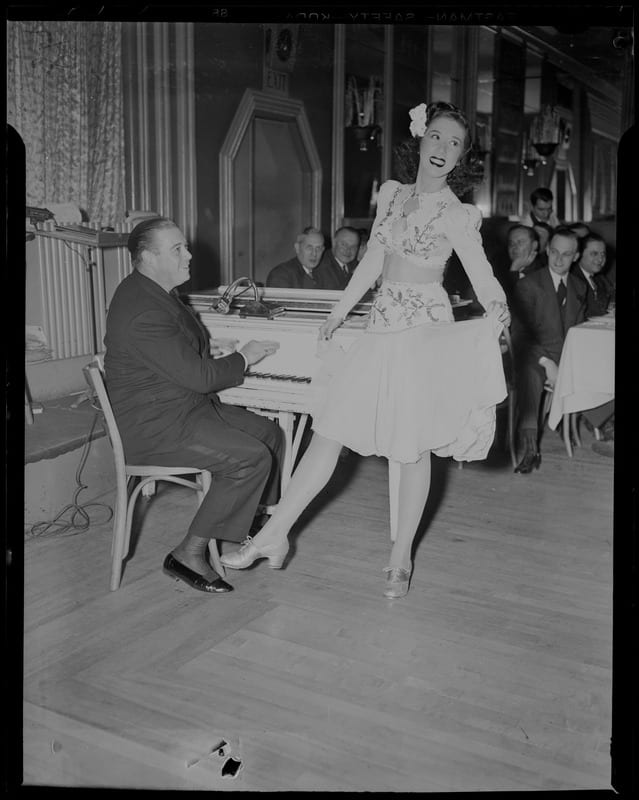A guest post by Claire Drone-Silvers, Research Services Librarian at the Boston Public Library.
In 1989, former president George H. W. Bush declared May 25 “National Tap Dance Day.” This date was selected to commemorate the birth of Bill “Bojangles” Robinson and his contributions to tap dance.
Learn more about this holiday and the history of tap dance:
A Brief History of Tap Dance
Dancer and scholar Constance Valis Hill describes tap as “a fusion of British and West African musical and step-dance traditions in America” that developed in the United States during the 1700s. This form of dance was often performed barefoot or in hard-soled shoes. In the United States, enslaved Africans and indentured Irish immigrants cultivated and shared their dance traditions. African American Juba dancing and Irish jig dancing developed together into "jigging." Jigging became popular in the 1800s as part of minstrel shows, where white performers in blackface appropriated Black songs and dances for their entertainment. One of the most famous dancers of this period was William Henry Lane, a free Black man whose incredible dancing earned him the name “Master Juba.” His dance style is considered to be "the earliest form of American tap dance."
In the early 1900s, the growing popularity of ragtime and jazz music shaped the history of tap dance. Metal "taps” were added to the bottom of shoes, giving the shoes, and the dance form, their name. Jazz tap dance developed from the interplay between jazz music – with its syncopated and complex rhythms – and tap dance. Other styles of tap dance, such as Broadway tap and rhythm tap, emerged later as tap appeared in theatre, film, and vaudeville. During the 1920s and 1930s, dancers like Bill Robinson, John Bubbles, and Cora LaRedd became famous for their performances in vaudeville and Broadway. Nightclubs like the Cotton Club in New York City flourished, although many such venues were segregated. While Black dancers and singers were allowed (and sought after) to perform, they performed to white-only audiences.
In the 1930s and 1940s, tap dancing became even more popular in theatre and film. Fred Astaire and Ginger Rogers dazzled audiences in their feature films and became household names. Meanwhile, women like Eleanor Powell and Jeni LeGon established careers for themselves in film and on Broadway. Although tap thrived in this era, the performance industry was still segregated. Black performers often had smaller roles in films and faced racial prejudice from management and other dancers. However, Black dancers continued to develop tap as an art form and achieved enormous popularity. Duos like the Nicholas Brothers and Coles & Atkins paved the way for future generations of dancers. When Bill "Bojangles" Robinson died in 1949, members of the tap community formed the Copasetics to honor his memory.
During the 1950s and 1960s, interest in tap dance had waned and many dancers could not find work. However, tap experienced a revival in the 1970s and 1980s and began to appear in film and on stage again. Members of the Copasetics, among others, mentored younger dancers like Savion Glover and Brenda Bufalino. Bufalino established the American Tap Dance Orchestra in 1986, whose mission was to legitimize tap as a dance form and contribute to its evolution. Glover has had a monumental career both as a dancer and a choreographer. His choreography, built on the foundation of jazz tap and rhythm, for Bring in 'da Noise, Bring in 'da Funk, earned him a Tony Award in 1996. Today, tap dance continues to evolve as an art form as new dancers learn from and build on its complex history.
Celebrating National Tap Dance Day
Celebrating National Tap Dance Day in the United States means celebrating the contributions of Black and immigrant artists. While many people are familiar with dancers like Gene Kelly and Fred Astaire, the accomplishments of many Black and female dancers are less well-known. You can celebrate the history and art of tap dance in the United States in a number of ways! Here are some suggestions:
- Enjoy some tap dancing (in-person or via film)! Check out Tapdancin’ (1980), Discovering Gene Kelly (2011), or The Artist (2011) on Kanopy or check out a DVD from the library. Please note that some films (especially from the 1920s-40s) may contain racially insensitive content.
- Familiarize yourself with the history of tap dance and the incredible tap dancers who made tap what it is today. Check out some of the library resources below for more information.
- Booklist: 21 Books and Videos for National Tap Dance Day
- Online resources: Dance in Video, Music & Performing Arts, Black Drama
- Take a class and learn how to tap dance! Use the Class Finder tool on the Boston Dance Alliance’s website to locate dance classes near you.



Add a comment to: Celebrate National Tap Dance Day